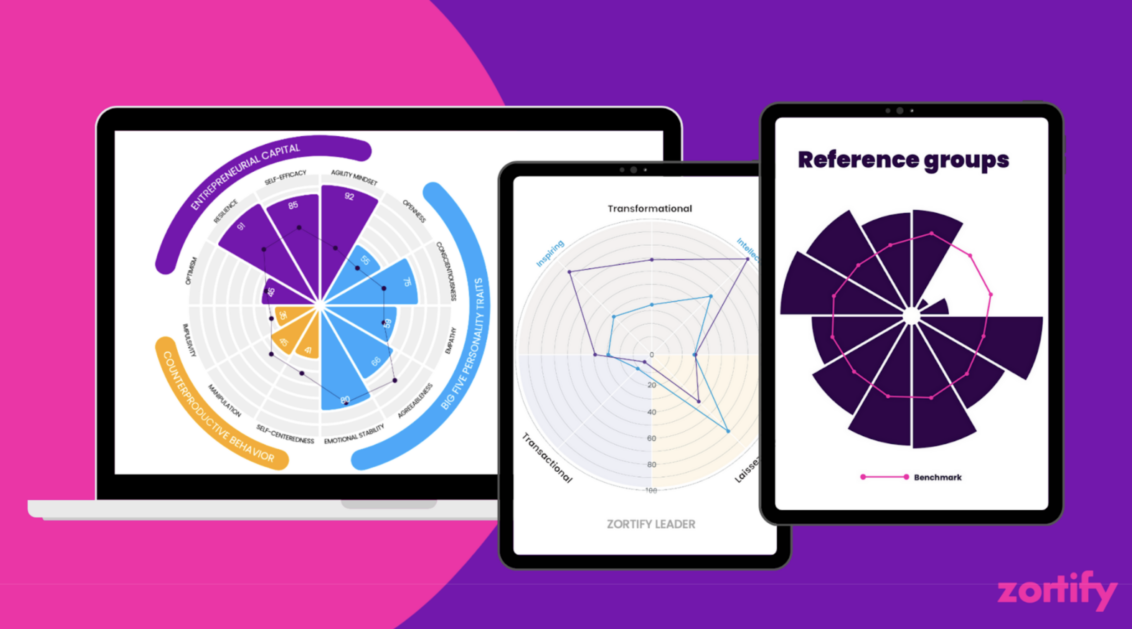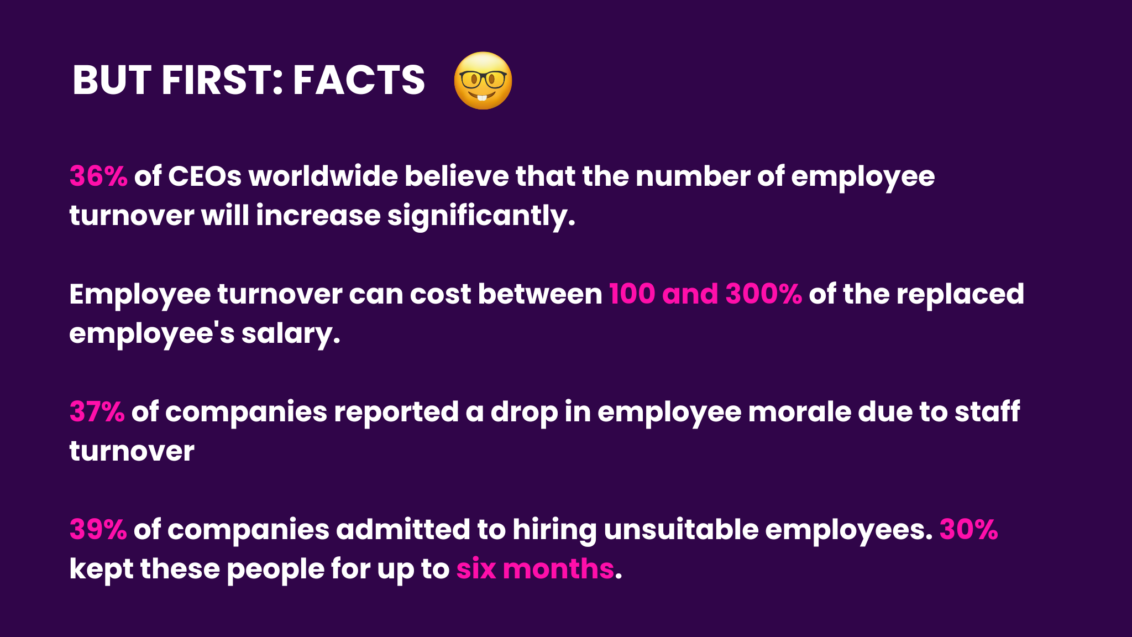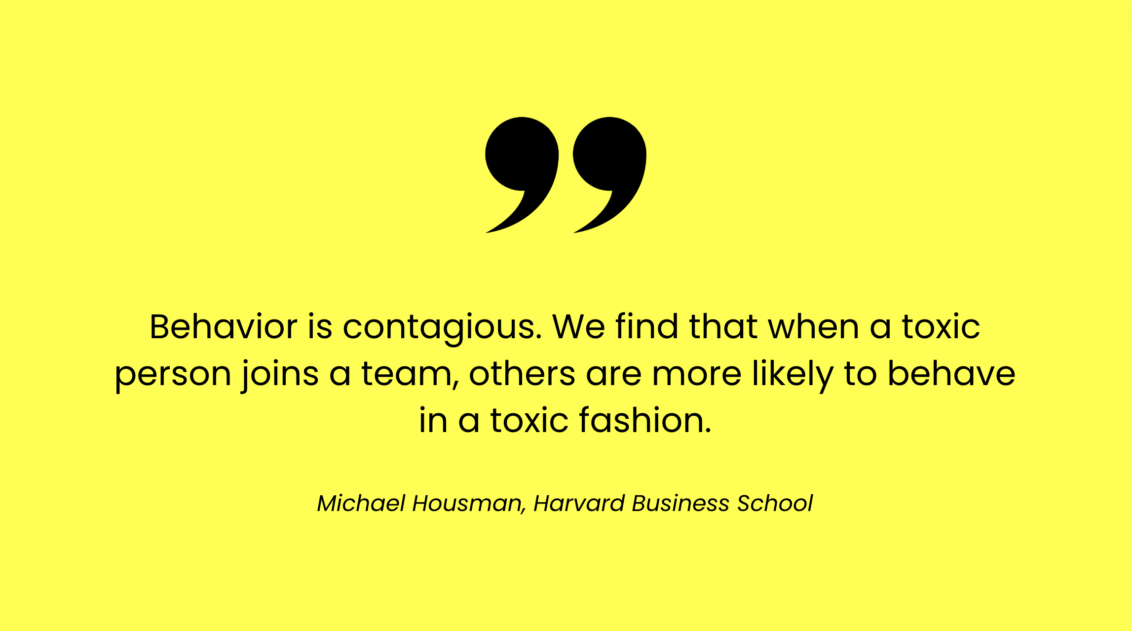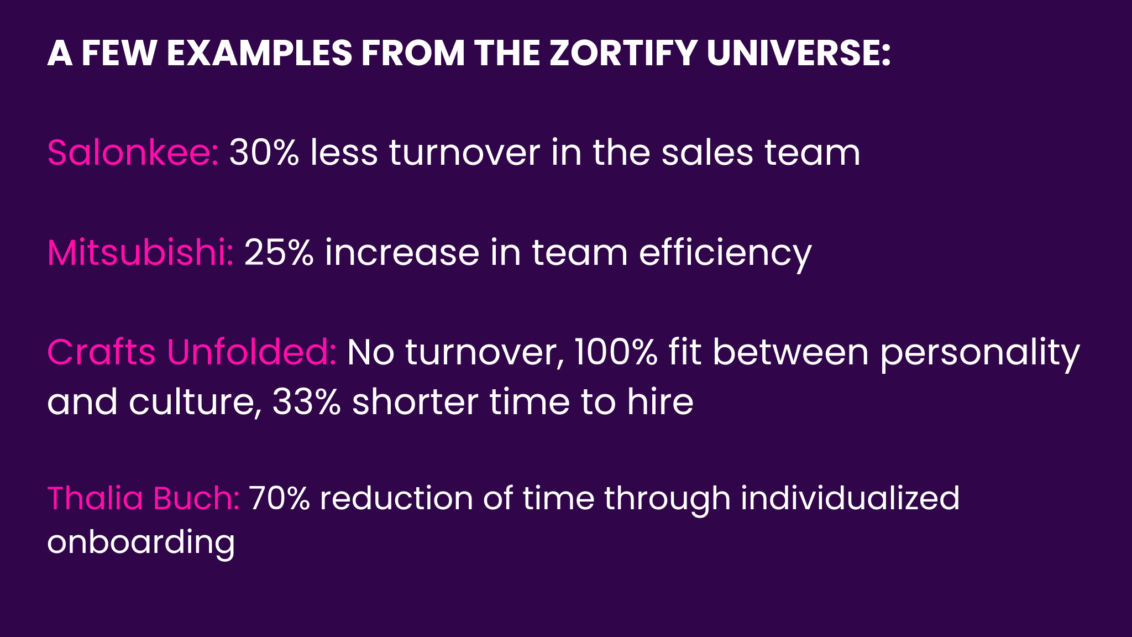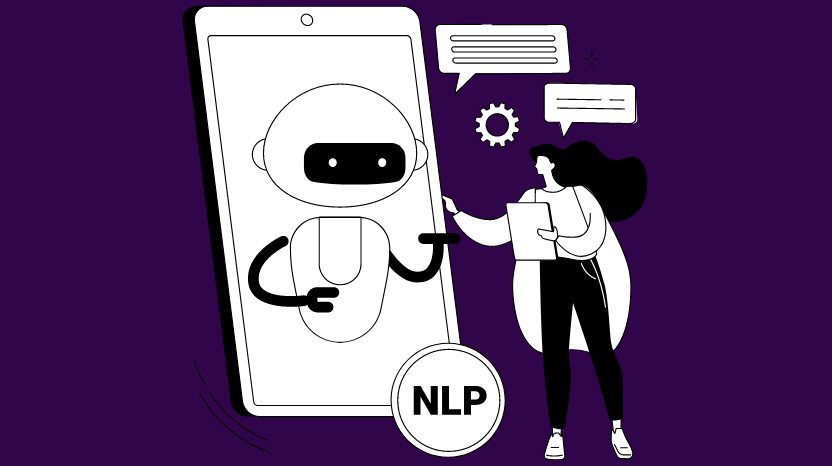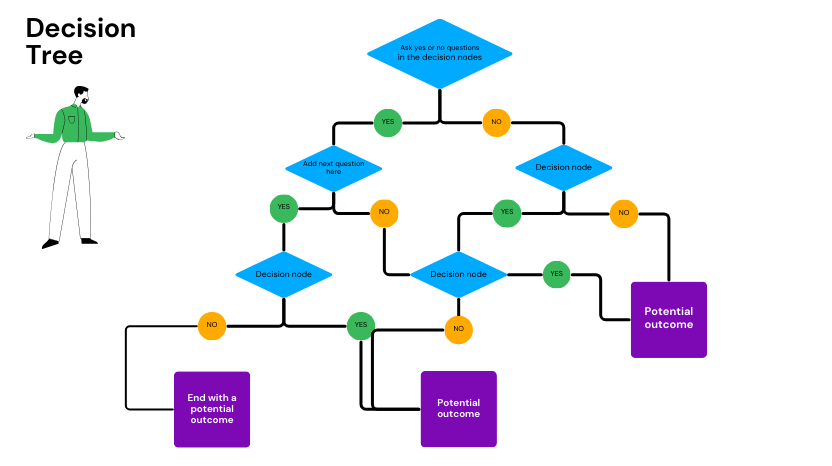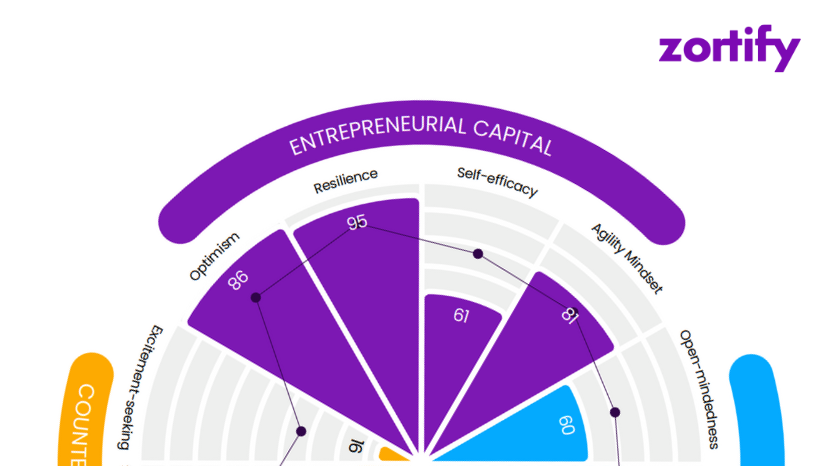AI literacy
These are the key skills for modern HR work
The use of AI systems will revolutionize the HR sector. Not using AI is no longer an option. It is now a matter of developing the necessary skills to be able to use the technology in a targeted manner. HR professionals need to start equipping themselves with the knowledge they need to use AI tools effectively while retaining the invaluable human judgment that machines cannot replace.
The good news is that HR professionals won’t need to be able to understand complex statistical formulas or code in the future. Rather, it’s about understanding HR metrics and being able to interpret data visualizations, including modern dashboards powered by AI. This fundamental understanding enables HR professionals to gain data-driven insights to solve real-world problems.
What will be better with AI
Research shows that only a small percentage of HR professionals have advanced AI skills. However, those who do use AI and data analytics report positive effects in recruiting, employee engagement and decision-making processes.
According to a study by Gartner, 76% of HR leaders believe that if their organization does not implement AI solutions in the next 12 to 24 months, it will lag behind those that do in terms of business success.
HR professionals need a basic understanding of how AI works, what the technology can and cannot do. They should focus on what benefits the technology can bring them and what specific use cases there are. In doing so, they should always keep the company’s goals in mind. What can they do better, faster and more cost-effectively with the help of AI in order to achieve these goals?
HR as change management
The introduction of AI in the HR department inevitably leads to changes in processes and possibly roles. Sometimes it is enough to integrate an AI tool into a workflow and thereby achieve an immediate benefit. Often, however, it is not that simple and a rethink and reengineering of the entire process is required. This shift requires a deep understanding of where human capabilities complement AI and add value to human judgment, data collection and actions.
After all, humans will remain irreplaceable in the future. AI tools have been developed to improve human skills and can be useful in delegating tasks. Technology will be omnipresent in most activities, rather than replacing them entirely. AI systems can often make better, faster and cheaper predictions than humans. However, a prediction is not a decision, it is merely a component. The real value lies in human judgment – the ability to interpret predictions, consider ethical implications and make decisions that machines cannot. HR professionals must address ethical dilemmas, privacy concerns and the need for a continuous learning and adaptation process.
The better HR managers understand the basic workings of AI systems, the better they will be able to argue in favor of their use. The extended basic understanding includes the following aspects:
- What model is AI based on? What is represented? What is left out?
- For what purpose was the AI built?
- What data was used to train it?
- How is the data entered used and stored?
- Is the AI legally compliant, for example with regard to the European AI Act?
In the future, another core competence will be not only mastering AI-related changes to tasks and processes, but also communicating them to the workforce, addressing resistance and offering training.
Data storytelling will become more important at the decision-making level in companies. HR professionals who have mastered it can influence decision-makers by presenting data-driven insights in a convincing narrative, for example to push through additional budgets for recruiting and HR marketing.
HR remains human
Despite the technical nature of AI, its primary goal in HR is to improve the human work experience and performance. HR professionals should therefore always take a human-centered approach when implementing new tools. At its core, it should be about understanding the needs and behaviors of employees and developing AI solutions that improve their work lives while making the organization as a whole more productive and successful. Skills in methods such as design thinking can be helpful here.
Staying agile
The future of HR work lies in combining the best of AI and human knowledge. Once HR leaders better understand what the technology can do, they can assess the potential use cases and benefits and harness the power of technology to improve their work. At the same time, they can ensure that human judgment remains at the heart of HR decision making. A balance between AI and humans is critical to creating efficient, equitable and human-centered HR practices that can continually adapt to a changing world of work.
✅ AI Literacy at a glance:
- Operating AI tools
- Interpreting AI-generated data
- Integrating findings from data analysis into current HR processes
- Understanding ethical and legal issues
- Communicating AI-related changes and benefits
- Human-centered design thinking
- Data storytelling
For recruiters, freelance coaches and consultants looking for a comprehensive AI toolkit, Zortify offers a certification program. This opens the door to a world of assessments that measure not only the traditional personality traits, but also the but also the counterproductive behavioral tendencies, and malleable psychological states crucial for professional and personal success.
The next certification dates:
- March 20-21, 2024, Zurich
Everyone wants these five colleagues in 2024
From “prompt engineer” to “AI ethicist” to “avatar fashion designer” – new technology is not only eliminating jobs, it is also creating many new fields of activity. This inspired us to think about the hurdles that HR managers in particular are currently facing and what support, new roles or professions there should be in HR to overcome them.
Expensive assessments, even more expensive bad hires
According to a study by Glassdoor, companies experience an increase in applications in January, while at the same time employee turnover goes up. For HR, this means juggling between recruiting new talent, conducting appreciative offboarding and keeping the existing workforce happy, often with limited budgets.
Missed the boat on AI? How companies are catching up
Artificial intelligence – we don’t need it. Many companies would probably have signed this sentence a year ago. ChatGPT had been released a few weeks earlier. Today, no company can avoid the question of what it is already using AI systems for.
How AI can save your HR budget
How to avoid expensive assessments – and even more expensive bad hires
As most companies probably don’t have a “bad hire budget”, they should do everything they can to avoid bad hires. More and more are using AI systems to replace expensive and inefficient methods such as assessment and development centers. AI-based employee diagnostics supports HR in doing the best possible job – and sets new standards in people development at the same time.
Customized HR work: cheaper than ever before thanks to AI
Understanding and using AI systems costs money at first, of course. But this is money well spent. With the help of artificial intelligence, HR is much more likely to fill open positions with the right people and the investment in onboarding and employee development will pay off in the long term.
How is this possible?
Technological change is making affordable what until recently was expensive: making accurate predictions about who will fit a job and who will not. The more sophisticated the technology becomes, the better HR experts can do their job.
AI systems can already:
-
- scan a large number of profiles of potentially interesting talents in social networks,
- create a pool of suitable candidates for active sourcing,
- create job descriptions that suitable talents really want to read and in which they can find themselves.
Above all, however, they make assessment and development centers obsolete. These involve an average of five days’ work for several HR managers and often cost tens of thousands of euros. At the same time, the many bad hires and the growing willingness to change jobs in the workforce show that they do not bring the desired outcome. AI systems can change the system. Within minutes, they analyze the information that HR needs to pre-select candidates and reduce the risk of a “bad hire”.
How to avoid the recruiting of toxic coworkers
In order to support the final decision, AI systems can analyze not only the personality profiles of applicants but also their potential fit with regard to their future role in the team. A Harvard study shows just how important this is. According to this study, a top performer with toxic behavioral traits has a worse impact on the overall performance of the company than several employees who only perform at an average level but work well as a team.
Anyone who thinks of the obvious bully when they hear the term “toxic worker” is mistaken. Toxic employees act cleverly and often poison the atmosphere in subtle ways. To avoid this, HR managers need to be able to identify personality traits in advance (i.e. before recruitment) that are not apparent from a CV or assessment center. Using this data, they can identify likely patterns of behaviour and predict how they might affect the performance of the team and the organization as a whole
In view of the increasingly complex field of HR tasks and the limits of the human ability to analyze, it was until now impossible to meet this expectation. With the rise of AI systems, this is changing. Data-supported personality analysis will very likely quickly become the new standard in employee recruitment and development and give companies more security in uncertain times.
Minimizing risk with AI
Speaking of uncertainty: in its latest issue, the “brandeins” magazine comes to the conclusion that the slow pace of digitalization in every fourth German company is due to a lack of willingness to take risks. AI can also spark a shift in thinking here: By accelerating processes and securing decisions based on data, companies can act more courageously and flexibly.
These impressive figures are a signal to risk-averse companies to invest in their digitalization even more, as new technologies can significantly reduce risks in important areas of corporate management, such as HR work.
Conclusion
Assuming you don’t have an endless “bad hire budget”, dare to invest in AI. Start low-threshold, for example with SaaS and platform solutions. Because one thing is clear: external risks will not become less in the foreseeable future, but they will be much easier to manage with AI. Companies can use AI-supported risk management and explore new fields with the help of data. The best insurance they have is the right employees who share their goals, values and culture.
Sources:
– Why Wallet Wellness Should Be HR’s Top Priority in 2024 and How Employers Can Stretch Employee Paychecks
– Thriving in an age of continuous reinvention
– Measure Workforce Resilience for Better Business Outcomes
– The real cost of employee turnover and what you can do about it
Everyone wants these five colleagues in 2024
From “prompt engineer” to “AI ethicist” to “avatar fashion designer” – new technology is not only eliminating jobs, it is also creating many new fields of activity. This inspired us to think about the hurdles that HR managers in particular are currently facing and what support, new roles or professions there should be in HR to overcome them.
Missed the boat on AI? How companies are catching up
Artificial intelligence – we don’t need it. Many companies would probably have signed this sentence a year ago. ChatGPT had been released a few weeks earlier. Today, no company can avoid the question of what it is already using AI systems for.
How Companies Get to the Bottom of Quiet Quitting
The topic of “Quitting” is stirring the HR world. People seem to be resigning in very different ways. Sometimes very officially, increasingly internally, often silently. Yet, what does it say about our work environment when people who do what is expected of them (no less, but also no more) are referred to as “Quitters”? – However, we don’t want to become too philosophical here.
Everyone wants these five colleagues* in 2024
(*or: this one AI)
From “prompt engineer” to “AI ethicist” to “avatar fashion designer” – new technology is not only eliminating jobs, it is also creating many new fields of activity. This inspired us to think about the hurdles that HR managers in particular are currently facing and what support, new roles or professions there should be in HR to overcome them. In the best “make a wish” style, we baked them these fantastic “wish colleagues” on the fly. The good thing is that many of the ingredients can already be found in AI applications. We’ll show you which ones.
1. Chief Talent Interpreter (CTI)
The Chief Talent Interpreter can read between the lines of CVs and questionnaires and recognize what remains hidden to others even on the second and third screen. He is a kind of crystal ball on two legs. And the results of its work are nothing short of magical.
After all, CVs and self-assessments provide HR with an initial impression of candidates and their suitability for certain positions. But far too often, it’s only when they start the job that it becomes clear what makes the person behind the written word tick, whether they can fulfill their new role and fit into the team. If this is not the case, things can get uncomfortable. In any case, it will be expensive (been there, done that 🙄). The Chief Talent Interpreter knows how to prevent this.
🎮 Colleague AI: The technological crystal ball is based on Natural Language Processing (NLP) and can interpret nuances in written responses. With its support, HR managers can identify the characteristics in a candidate’s personality profile that are important for a role and assess whether a person will fit into the corporate culture. It therefore replaces CV analysis as well as time-consuming assessment and development centers.
2. Employee Wellbeing Analyst
He not only reads what you write, but also understands what you actually want to say. He decodes hidden messages and calls for help that are hidden subtly and unnoticed by readers in written communication. High-frequency nuances in emails or interviews are picked up by his highly sensitive antennae. This enables him to speak directly to the employees concerned and find out what they need, or give the manager a confident hint that a conversation would be useful.
🎮 Colleague AI: (Our) AI systems can already read psychological dimensions from written everyday communication. Meanwhile, researchers are continuing to work on training AI in emotional intelligence (EQ). This will enable AI systems to analyze human emotions and their impact on decisions in the future. Chatbots and virtual assistants will be able to recognize emotional nuances in communication and react to them, for example in employee interviews. Good for HR: AI-controlled tools will soon be able to offer them individual training and coaching programs to train their EQ.
3. Team Dynamics Engineer
This fantastic new colleague helps individual employees to understand themselves better and also promotes effective collaboration in teams. She can predict whether the chemistry between potential team colleagues will be right based on individual psychological profiles. After all, she knows that good teamwork depends not only on skills and tools, but also on the psychological preferences of the individual team members. Therefore, even after the team has started work, she tirelessly ensures that everyone has their own safe space to express themselves freely. She always keeps an eye on how the team is currently working together and where improvements are needed.
🎮 Colleague AI: …can already use NLP to analyze employee profiles in order to form teams that not only complement each other professionally, but are also psychologically compatible. Our “High-Performance Teams” AI, for example, divides work into six basic roles. This helps employees to assess for themselves how they can and want to work. Also which role they should therefore take on in the team.
4. Customized Development Pathfinder
The “design and deliver” principle, whereby career options are set out once in the company and then never touched again. Has long since been overtaken by reality. In this reality, we have self-confident employees who want to decide for themselves when and in which direction they want to develop. At their own pace and according to their individual goals. The Customized Development Pathfinder supports them in this. He knows what each individual is good at and also gives a nudge forward when employees fall short of their potential.
🎮 Colleague AI: … also knows exactly what knowledge and skills lie dormant in the workforce. It uses psychological analyses of employees’ needs and aspirations to create personal development plans. Our zortifyGROW AI, for example, measures stable personality traits and adaptable personality states and links them to professional development. It uses a unique combination of the “Big Five Personality Traits” model, the “Entrepreneurial Capital Personality” model and the “Counterproductive Behavioral Tendencies” model. Nerdy by nature – and very accurate. 🤓
5. Chief Asshole Detector
The colleague with the swear word in his title is actually an extremely sensitive soul. He senses vibrations as soon as a person enters the room and reads precisely between the lines. He is not impressed by fancy titles and CVs; he has X-ray vision, looks behind the façade and analyzes with a cool head whether someone could damage the heart of the organization. With the right decision, he can prevent bad hires and save the company from high costs and a negative vibe among the workforce.
🎮 Colleague AI: … truly cannot be accused of being guided by sympathies and bad previous experiences when evaluating a person. It unemotionally analyzes the spoken and written word. Based on the results, it shows whether an applicant has narcissistic traits that could severely disrupt the company and poison the culture. AI can already see what humans cannot detect even on second glance. And would have reliably spared the national economy the 14 percent of narcissists in management roles.
What’s to come
2023 was a super exciting year for companies and for HR in particular. Artificial intelligence has opened up many new opportunities to place the right people in the right positions at the right time. In the end, that’s what makes HR work so valuable and also so fulfilling, isn’t it? And the development is continuing at a rapid pace. The tasks of all the dream colleagues described above can already be performed by just one AI.
What does this mean for other, non-fictional jobs? Will human labor become largely obsolete in the future? – Certainly for certain tasks. At the same time, there will be many new tasks that will require human and machine intelligence working side by side to achieve the best results. In 2024, companies will be all the more challenged to find the right balance between the two. And for those organizations that have not yet had any contact with AI, it’s time to get to grips with the topic and get started step by step. We have described how this can be done in another post.
We hope that you can spend a lot of time with the people who are good for you in the new year. Both in your private life and at work. Thanks to AI technology, the chances of this are good.
With this in mind: Happy 2024!
Quiet Thriving Over Quiet Quitting
AI’s Role in Fostering Proactive Work Culture. Every movement has its counter-movement, and this is also true in the HR sector. While “Quiet Quitting” describes a state in which employees do just the bare minimum, “Quiet Thriving” represents a concept that encourages people to actively participate and shape their own work environment.
Lead Effectively: Speak 20%, Actively Listen 80%!*
*(Spoiler: AI makes it possible)
Hand on heart: Do you know the current state of well-being of your employees? Do you understand their worries, challenges, and feelings? Do you know what truly moves them, what challenges they face, what is going well for them, and where they urgently need support?
Missed the boat on AI? How companies are catching up
Artificial intelligence – we don’t need it. Many companies would probably have signed this sentence a year ago. ChatGPT had been released a few weeks earlier. Today, no company can avoid the question of what it is already using AI systems for.
Missed the boat on AI?
How companies are catching up
Artificial intelligence – we don’t need it. Many companies would probably have signed this sentence a year ago. ChatGPT had been released a few weeks earlier. Today, no company can avoid the question of what it is already using AI systems for. According to a Bitkom study, two thirds of companies consider AI to be the most important technology of the future. At the same time, 38 percent are concerned that they have missed the boat on new developments. They should know that it is not too late to start (and there is probably no alternative), because AI is here to stay and will change and shape almost every area of our working world in the coming years. Companies that are still unsure about how AI will affect their work can take a step-by-step approach. HR is an ideal area for this. I’ll come to why and how this can work in detail in a moment.
No AI is not a solution either
The first step, however, is to overcome general fears of AI. This can be achieved by consciously questioning and adapting our own mindset. Companies can accept that they do not yet understand everything. They can allow themselves to learn and try out new things. It also helps to realize that they are probably already using AI as a matter of fact without even realizing it – see the following illustration:
These examples also show that organizations do not have to immediately purchase a large, complex software package costing several million euros. Instead, they can start small and proceed step by step. In that way, they can gradually open up areas in which AI systems can bring them measurable improvements. In the Bitkom study mentioned above, for example, more than half of the companies using Artificial Intelligence highlighted the reduction of human error as one of the greatest benefits, followed by the acceleration of processes.
Improving HR work with AI
Especially in HR, AI systems can make work easier and bring benefits for both HR experts and employees. The following areas of application are already showing good results:
1. AI diagnostics: personality tests and skills analyses to gain deeper insights into employees’ strengths and development potential.
2. Employee development: AI-supported learning and development programs that are individually tailored to employees’ needs and career goals.
3. Recruitment: tailored job advertisements, talent acquisition, including automated CV analysis and pre-selection of suitable candidates.
4. Process automation: time tracking, leave management and onboarding.
5. Performance assessment.
6. Employee engagement and satisfaction: AI analysis of employee feedback and sentiment to identify trends and proactively address needs.
7. Diversity management: AI-supported analyses to promote diversity and inclusion in the company.
Ask the right questions* in advance (*here they come)
To get started in your company, you should first ask yourself which of the areas mentioned above would benefit most from AI. What specific challenges in diagnostics, employee development, recruitment and other HR processes do you want to address? Define specific, measurable goals that you want to achieve with the help of AI.
In the next step, look for possible providers. Ask yourselves: What experience and references do the various AI providers have specifically in the HR context? And: How do the functions of the AI tools on offer cover our specific HR requirements?
After a pre-selection, look at the details
- Data protection: how do the providers ensure the protection and confidentiality of employee data?
- User-friendliness and training requirements: How user-friendly are the tools and what level of training is required for the HR team?
- System integration and technical requirements: How can the AI tools be integrated into our existing HR infrastructure?
- Provider support and technical maintenance: What support does the provider offer for technical or usage-related issues?
- Risk management and data security: What security measures and emergency strategies are implemented for the AI tools?
Then focus once again on your resources, goals and values. Weigh up the costs and benefits: what return on investment can you expect from using the AI tools? Ethical questions should also be discussed at this point at the latest: How do you ensure that the AI solutions comply with ethical standards and make decisions free from bias? – Many providers of AI systems have dealt intensively with the legal and ethical framework conditions in recent years and can provide support here.
Address resistance within the workforce and create a shared understanding of how Artificial Intelligence can be used in the company and where the (current) boundaries lie. At the same time, you can contribute to a better understanding of the technology and reduce fears with further training programs. (Spoiler: zortify also offers coaching on AI. 🤓) Give employees the freedom they need and encourage them to learn more about AI on their own. And finally: start small – with pilot projects and hands-on tools that don’t require time-consuming implementation and allow you to exit at any time. Start with one aspect of HR work, learn from the experience and then gradually expand the application as the technology benefits you.
Conclusion
The sudden rise and rapid development of Artificial Intelligence has overwhelmed many companies. But as with all new technologies, it’s perfectly okay not to be one of the first, the early adopters. But it is not good to permanently turn a blind eye to new developments and opportunities. Especially not if they benefit the company and the people who put their skills and time at the service of the organization. Find out what AI can do for you in specific terms. Try things out, reflect, adapt and, as in other areas of life, trust your common sense. It will be a good compass for you when dealing with AI and navigate you through the fascinating possibilities that new technology offers.
AI vs. Human Intelligence
Examining the differences between AI and Human Intelligence, and how they can work together to drive Innovation. Artificial intelligence (AI) has been a hot topic in recent years, with advancements in technology and machine learning leading to significant improvements.
Building Trust with Explainable AI: Techniques and Approaches
As AI becomes more pervasive in our lives, it’s becoming increasingly important to understand how these systems work and to be able to trust their decisions. Explainable AI (XAI) is a growing field that aims to create more transparent and interpretable machine learning models.
NLP 101: A Beginner’s Guide to Natural Language Processing
Natural Language Processing (NLP) is a field of study that focuses on analysis and synthesis of human language. NLP is a fascinating and rapidly evolving field with a wide range of applications, from chatbots and virtual assistants to sentiment analysis and machine translation.
NLP in Business
How Natural Language Processing is Transforming Customer Service, Marketing, and Sales
As businesses become more customer-centric, understanding customer needs and wants is becoming increasingly important. Natural Language Processing (NLP) is a branch of Artificial Intelligence (AI) that is revolutionizing the way businesses interact with their customers. By analyzing language data, NLP enables businesses to gain a deeper understanding of their customers, improve communication, and automate processes.
Here are some ways that NLP is transforming customer service, marketing, sales, and even the workplace:
Improving Customer Service Interactions
NLP is being used to analyze customer feedback and interactions to improve the overall customer experience. By analyzing customer feedback in real time, businesses can identify common pain points and issues and address them promptly. NLP can also be used to automate customer service interactions through chatbots and virtual assistants, reducing wait times and providing 24/7 support.
Automating Marketing and Sales Processes
NLP is being used to automate marketing and sales processes, allowing businesses to personalize their messaging and improve customer engagement. By analyzing customer interactions and (meta)data, AI and NLP can generate personalized recommendations and product suggestions. This level of personalization can improve customer retention and loyalty, and increase revenue.
Gaining Insights from Unstructured Data
NLP is also being used to analyze unstructured data, such as social media comments and reviews, to gain insights into customer sentiment and preferences. By analyzing this data, businesses can gain a deeper understanding of their customers and adjust their marketing and sales strategies accordingly.
Challenges and Considerations
While NLP has many benefits for businesses, there are also challenges and considerations to be aware of. For example, NLP algorithms can be biased, reflecting the biases of their creators and the data they are trained on. This can result in unfair or discriminatory outcomes. Additionally, NLP may not always accurately capture the nuances of human language, leading to errors or misunderstandings.
NLP in business
At Zortify, we believe that natural language processing (NLP) is a critical tool in driving better decision-making through artificial intelligence. That’s why we’ve built our company around NLP and its applications in human experience management (HXM).
Our Zortify products are based on the latest research and practical expertise in Data & Computer Science, NLP, Visual Computing, Psychology, and People Analytics. We believe that this multidisciplinary approach is key to developing usable and explainable AI solutions that truly make a difference.
One of our primary applications of NLP is in making active listening scalable for organizations across Europe. Our technology enables individuals to express themselves in their own words, whether it’s for personnel selection, customer/employee feedback, or analyzing an entire organization’s culture. By leveraging NLP, we can capture and understand the nuances of human language in a way that wasn’t previously possible.
Conclusion
NLP is transforming the way businesses interact with their customers, enabling them to gain a deeper understanding of customer needs and wants, improve communication, and automate processes. As with any technology, there are considerations and challenges to be aware of. However, by using NLP responsibly and ethically, businesses can improve the overall customer experience and drive growth.
NLP 101: A Beginner’s Guide to Natural Language Processing
Natural Language Processing (NLP) is a field of study that focuses on analysis and synthesis of human language. NLP is a fascinating and rapidly evolving field with a wide range of applications, from chatbots and virtual assistants to sentiment analysis and machine translation.
AI vs. Human Intelligence
Examining the differences between AI and Human Intelligence, and how they can work together to drive Innovation. Artificial intelligence (AI) has been a hot topic in recent years, with advancements in technology and machine learning leading to significant improvements.
Building Trust with Explainable AI: Techniques and Approaches
As AI becomes more pervasive in our lives, it’s becoming increasingly important to understand how these systems work and to be able to trust their decisions. Explainable AI (XAI) is a growing field that aims to create more transparent and interpretable machine learning models.
XAI: Building Trust and Transparency in Machine Learning Models
As AI becomes more pervasive in our lives, it’s becoming increasingly important to understand how these systems work and to be able to trust their decisions. Explainable AI (XAI) is a growing field that aims to create more transparent and interpretable machine learning models. In this article, we’ll explore what XAI is, why it’s important, and how techniques such as decision trees and rule-based systems can be used to build more transparent and trustworthy AI systems.
Introduction
Artificial intelligence (AI) is increasingly being used in a wide range of applications, from chatbots to autonomous vehicles. However, as AI becomes more ubiquitous, concerns have arisen about its transparency and accountability. In particular, there is a growing demand for AI systems that are explainable. Meaning that they can be understood and interpreted by humans. This article will explore the concept of explainable AI, including why it’s important for building trust in AI systems. And how techniques such as decision trees and rule-based systems can be used to create more transparent and interpretable models.
What is Explainable AI?
Explainable AI (XAI) is a subfield of AI that focuses on developing methods and techniques to make AI systems more transparent and interpretable. The goal of XAI is to enable humans to understand the reasoning behind AI decisions and action. Which is critical for building trust in these systems. XAI is especially important in high-stakes applications. Such as healthcare and finance, where decisions made by AI systems can have significant consequences.
Why is Explainable AI Important?
The lack of transparency and interpretability in AI systems is a major obstacle to their widespread adoption. If people cannot understand how an AI system is making decisions or why it is taking a particular action, they are unlikely to trust or rely on that system. This is particularly true in applications where human lives or livelihoods are at stake.
Another reason why XAI is important is that it can help identify and mitigate biases in AI systems. Many machine learning models are trained on biased data, which can lead to discriminatory outcomes. By making AI systems more transparent and interpretable, it becomes easier to identify and correct biases in these models.
How can we achieve Explainable AI?
Several techniques and approaches can be used to achieve XAI. One common approach is to use decision trees. Which are a type of model that creates a tree-like structure of decisions and their possible consequences. Decision trees are easy to understand and can be used to trace the reasoning behind AI decisions.
Exemple of decision tree
Another approach is to use rule-based systems, which are sets of rules that define the conditions under which certain actions should be taken. Rule-based systems are often used in expert systems. Which are AI systems that simulate the decision-making capabilities of a human expert in a particular domain.
A third approach is to use model-agnostic techniques, such as LIME (Local Interpretable Model-Agnostic Explanations) or SHAP (Shapley Additive exPlanations). These techniques can be used with any type of machine learning model and provide local explanations for individual predictions.
Finally
Explainable AI is critical for building trust and transparency in AI systems. By making AI systems more transparent and interpretable, we can identify and correct biases, build trust with users, and ensure that AI is used ethically and responsibly. There are many techniques and approaches to achieving XAI, and organizations should carefully consider their options when implementing AI systems.
NLP 101: A Beginner’s Guide to Natural Language Processing
Natural Language Processing (NLP) is a field of study that focuses on analysis and synthesis of human language. NLP is a fascinating and rapidly evolving field with a wide range of applications, from chatbots and virtual assistants to sentiment analysis and machine translation.
AI vs. Human Intelligence
Examining the differences between AI and Human Intelligence, and how they can work together to drive Innovation. Artificial intelligence (AI) has been a hot topic in recent years, with advancements in technology and machine learning leading to significant improvements.
Natural Language Processing in Business
As businesses become more customer-centric, understanding customer needs and wants is becoming increasingly important. Natural Language Processing (NLP) is a branch of Artificial Intelligence (AI) that is revolutionizing the way businesses interact with their customers.
How Companies Get to the Bottom of Quiet Quitting
The topic of “Quitting” is stirring the HR world. People seem to be resigning in very different ways. Sometimes very officially, increasingly internally, often silently. Yet, what does it say about our work environment when people who do what is expected of them (no less, but also no more) are referred to as “Quitters”? – However, we don’t want to become too philosophical here. The fact is: people feel less connected to their employers today than the generations before them. According to a recent study by EY, only 13% of respondents feel a strong bond to the company (for comparison: in 2017 it was still 34%). For companies, this is both a curse and a blessing at the same time.
The Facets of Quiet Quitting
Let’s start with “Quiet Quitting”. This includes the phenomenon where employees stay in the company, but emotionally and intellectually switch off. They only do the bare minimum and reduce their productivity, creativity, and interaction with colleagues to the required minimum. Not because they feel powerless and unmotivated, but quite consciously, to not let work take up too much space in their lives. Especially among young employees, this attitude was temporarily proclaimed a trend. But is this form of “Quitting” really a problem? – This requires a nuanced view: I think it is quite legitimate for an employee not to constantly go above and beyond the expected. Emotional distance from the company can also be healthy.
When Quiet Quitting Becomes a Problem
The problem arises when employees start to actively block processes and structures, both on formal and informal levels. For example, quite bluntly put, when informal conversations at the coffee machine are refused because they are not part of the employment contract. Such behavior can, if it affects more than just a few employees, lead to a toxic company culture. And can even bring organizations to a standstill. Not all processes can be formally defined. Informal approaches to tasks and challenges can facilitate and expedite work in many areas. Where this dynamic comes to a halt, work also becomes difficult for those who are actually enjoying their work. The risk of resignation increases, especially when there are sufficient job alternatives in the industry.
So, it can be concluded: Quiet Quitting as a conscious action becomes a problem when it blocks or downright poisons the informal and interpersonal in organizations, potentially making work less attractive for all employees.
Detecting and Addressing Silent Resignation
But there is also another form of silent resignation. One that does not come preventively, but as a reaction to the existing working conditions. I would like to refer to it here as “Inner Quitting”. Employees who do not feel seen, do not receive recognition, and do not see the value of their work reflected in tangible results or emotionally, eventually only do the absolute minimum, increasingly become numb and often fall far behind what they could and would achieve in a positive work environment. This form of quitting happens more subconsciously and is not targeted. However, the consequences for the atmosphere among the workforce can be similar to those of consciously working on a low flame.
Regardless of the reasons for the silent retreat. It is vital for companies to continuously detect and counteract such negative developments. For this, they need to find out how their employees are really doing – candidly and unfiltered.
Artificial Intelligence Provides True Employee Insights
Getting authentic insights into the emotions and motives of employees, especially those who feel little connection to the company, is challenging. Traditional, quantitative employee surveys often reach their limits as they can lead to standardized and thus potentially biased answers. Quiet Quitters are likely to hold back or distort their true feelings and thoughts in conventional surveys. Making it difficult to gain a genuine insight into their perspectives and experiences. Here, the use of AI and especially Large Language Model (LLM) technologies can make a significant difference.
LLM-based technology, used in the HR context, is capable of analyzing and evaluating qualitative answers – i.e., text responses – and identifying subtle hints and patterns in the expression of employees. This makes it possible to understand what is actually going on in the minds of the people in the organization. Which needs remain unmet, and where there may be toxic behaviors or structures that undermine employee satisfaction and loyalty. By combining quantitative and qualitative data enabled by AI analyses, companies can gain a deeper, nuanced perspective on the needs and challenges of their teams. And thus make better informed and targeted decisions to improve leadership and corporate culture.
Setting Employees on Default with AI
Conclusion: The multifaceted act of “Quitting” – whether visible and loud, quiet and strategic, or latently internal – reflects the urgency to listen to the desire for change on the part of many employees. This change must be initiated by the people in leadership positions. They have never been better positioned to do so than today. Because AI-based technology is a game changer, especially in HR work. Companies should be bold and loud in going forward and using the new possibilities when it comes to the most valuable thing they have: employees who by default want to do good work.
Quiet Thriving Over Quiet Quitting
AI’s Role in Fostering Proactive Work Culture. Every movement has its counter-movement, and this is also true in the HR sector. While “Quiet Quitting” describes a state in which employees do just the bare minimum, “Quiet Thriving” represents a concept that encourages people to actively participate and shape their own work environment.
Lead Effectively: Speak 20%, Actively Listen 80%!*
*(Spoiler: AI makes it possible)
Hand on heart: Do you know the current state of well-being of your employees? Do you understand their worries, challenges, and feelings? Do you know what truly moves them, what challenges they face, what is going well for them, and where they urgently need support?
Attention, narcissism!
Unveiling the truth about narcissism and its impact on teams and companies, discover how AI can now recognize such behavior. From charismatic allure to detrimental consequences, narcissists can disrupt success in various ways. Explore the prevalence of narcissistic traits in executive suites and the alarming trends among younger generations.
What is Entrepreneurial Capital that we measure at Zortify?
Entrepreneurial capital is like a secret weapon for business people, whether you are an entrepreneur, corporate employee or leader – you want to score high in entrepreneurial capital. It’s made up of certain mental powers that help you do well in your work and handle challenges bravely. It’s not about skills or personality traits, it’s about your mindset, how you think and deal with things.
Imagine having an invisible shield that helps you stay strong during hard times and makes running your business and lead your people smoother. That’s what entrepreneurial capital does. It helps you to not give up, believe in your ability, and always expect good things to happen.
The Wonderful Things About Having Entrepreneurial Capital
When a person has lots of entrepreneurial capital, they usually feel better, do their work happily, and achieve more because they can handle stress and problems effectively.
For a whole company, when everyone has high entrepreneurial capital, it leads to good performance all around, and it even earns more money for the company. In fact, high levels of entrepreneurial capital correlates positively with employee engagement, psychological wellbeing, performance, and authentic leadership. (Same research shows that low levels correlate with everything we want to avoid in business i.e., cynicism, high staff turnover, job-stress, anxiety, workplace deviance…)
Resilience: Bouncing Forward and Growing
Imagine a tree. When a storm comes, it bends in the wind. After the storm, it doesn’t just return to its previous shape; it grows even stronger and adapts to withstand future storms better. This is what resilience in the business world is like. It’s not only about coming back to where we were after facing challenges but also bouncing forward, learning, and growing from those experiences. When life throws difficulties our way, we use them as stepping stones to become even more robust and adaptive.
Optimism: The Sun Always Follows the Rain
Optimism signifies maintaining a positive outlook and persistently expecting favourable outcomes. Just like after every spell of rain, we anticipate the sun to shine again, an optimistic mindset in entrepreneurial capital embodies believing that after challenging or difficult periods, positive and prosperous times will follow. This faith in a brighter future drives our actions and decisions, it also makes us more courageous and risk-taking.
Self-Efficacy Conviction: Steering Our Own Ship
Self-efficacy conviction is similar to having an internal locus of control, where we believe that we have the steering wheel of our career journey in our hands. Imagine being the captain of a ship. Regardless of the turbulent seas or calm waters, it’s our belief in our ability to navigate through these varying conditions that defines our self-efficacy conviction. We see that our actions, decisions, and strategies significantly influence our career journey and achievements.
Agility Mindset: Dancing Through Dynamic Shifts
Envision a dancer, seamlessly flowing with the rhythm, effortlessly adapting to every beat change. An agility mindset in entrepreneurial capital mirrors this dancer, gracefully pivoting through the erratic beats of the business world, ensuring each unexpected move becomes a choreographed step towards success. With an agility mindset you embrace change, convert challenges into new opportunities, always staying in sync with the fluctuating markets and trends.
Developing Entrepreneurial Capital: Is it Possible?
Absolutely! Cultivating entrepreneurial capital is achievable by nurturing resilience, self-efficacy conviction, optimism, and an agility mindset, thereby enabling any individual to flourish. This is perfectly done through coaching, workshops, training and even meditation and self-reflection.
In conclusion, entrepreneurial capital is like a secret tool that helps us and our teams to do well in business. By focusing on growing our resilience, self-efficacy conviction, and optimism, not only do we become better entrepreneurs, but we also make our businesses stronger and more successful.
Unlock the Secret Weapon for Success!
Ready to harness this power for your success? Contact Sophia today to discover how Entrepreneurial Capital can elevate you and your company to new heights!
Sophia
Karlsson
Business Development & HX Consultant
From Quiet Quitting to Quiet Thriving
How AI promotes a proactive work culture
Every movement has its counter-movement. This is also the case in HR. While “Quiet Quitting” describes a state in which employees only do the bare minimum, “Quiet Thriving” is a concept that encourages people to actively and creatively participate in their work sphere.
A proactive counter-design
The idea behind this approach is that people have a fundamental need for joy, development and fulfillment in their work. This creates motivation to not just strive for the minimum, even in a working environment that is perceived as rather negative, but to take on a proactive role. Such an attitude contributes to mental health and makes it possible to positively shape the environment within one’s own capabilities.
Exploring the possibilities
The “Circle of Control, Influence and Concern“, a model from positive psychology, shows the different levels of influence and the resulting options for action. It illustrates very well that some things are within our control and others are not. Recognizing and differentiating between them paves the way to more (inner) freedom and enjoyment of our own actions, even under suboptimal conditions.
In relation to the work context, this essentially raises three questions:
- If I cannot control or influence my work environment, can I learn to accept it? (e.g. the behavior of my manager)
- If a problem in my work environment is not within my control, can I influence it so that I experience at least some enjoyment at work? (e.g. work routine)
- What is within my control? How can I gradually increase my scope of action in order to not only do the bare minimum, but to develop and contribute my own ideas out of an inner drive that pay into the company’s goals? Not out of obligation, but out of an authentic motivation that enhances me both personally and professionally?
In “Quiet Thriving”, employees consciously deal with their self-efficacy (however small it may be), proactively shape aspects that they can influence and adjust their attitudes and reactions with a look at the things that they cannot (initially) change. They also network with like-minded people and build a supportive community together in order to strengthen and utilize their collective self-efficacy.
Happier work thanks to AI
From an HR perspective, employees who perform monotonous tasks or tasks that are perceived as less meaningful are particularly prone to “quiet quitting”. Especially if they cannot see the immediate effect of their work and therefore do not feel valued. This is where HR can take targeted action and help shape the scope to promote “thriving”. One requirement for this is that HR employees recognize the emotional state of employees. Artificial intelligence (AI), which works with comprehensive language models (as we know them from ChatGPT), can help here. It determines how people in the organization are actually feeling by evaluating qualitative data (e.g. open text responses in a survey). Based on this data, HR can show demotivated and dissatisfied employees development and learning opportunities or enable a temporary transfer to another job.
For example, job rotations or further training can break established patterns, offer variety and provide new inspiration. Which development step is suitable for which employee can also be determined by the AI. It is important that these offers do not come as an additional burden “on top” and increase the employee’s workload, but represent a real alternative to the previous area of responsibility. A deep understanding of employees’ character traits, conditions and needs can also help to place the right people in the right roles within the organization at the right time and thus create optimal conditions for them to perform their tasks with motivation. Thanks to AI, HR has the opportunity for the first time to delve deep into the organization and unleash the full human potential that lies dormant within it.
Know your Privilege – and use it for the better.
It is important for me to emphasize that “Quiet Thriving” represents a privileged approach that is not applicable to all life and work situations. On the work side, it is particularly suitable for office jobs and industries in which skilled workers are scarce and employees have a certain amount of power. At the same time, the knowledge of the diverse nature of work experiences and environments should be an incentive for companies to make working life appreciative and fulfilling for as many people as possible. Emerging AI technology offers fascinating opportunities here. Let’s use them to leverage the creative potential that lies dormant in everyone.
Empowered teams: doing the right thing (instead of doing everything right)
What is more important on the job – doing things right or doing the right things? – Most people will probably answer “both”. Nevertheless, in the context of changing corporate cultures, it is worth thinking about this question in its absolute either-or variant.
Good leadership: With self-reflection and unsympathetic filter
A good leader – is that something you are or is that something you become? – Let me put it this way: you are one if you are willing to become one. In other words, leadership requires a willingness to develop. Leading always means learning to lead. It is an ongoing process that is never finished, especially in the fast-paced world we live in.
The self-made skills shortage
Why should we analyze applicants in depth if we have no choice about who we hire anyway? We hear this question a lot. It reflects the frustration many companies feel about the lack of skilled workers. And rightly so? – We say: Yes and no. For one thing, we think that the shortage of skilled workers is not a “force of nature” that companies are helplessly exposed to.
Why Due Diligence matters
The importance of personality analysis in investment decisions
Due diligence is a crucial part of any investment decision, especially when it comes to startups. While financial, legal, and tax aspects are often thoroughly examined, there is one aspect that is sometimes overlooked: the personality of the founders. This article explains why personality analysis is so important for founders and investors, and how it can be integrated into due diligence processes.
First invest in personalities – Then in ideas
Ideas are a dime a dozen, but the personalities of the founders play a decisive role in determining how successful the implementation will be. Therefore, investors should not only check the business in their due diligence, but also the personality behind it. Research shows that an ideal founder personality consists of optimism, a willingness to take risks, and a strong belief in one’s own abilities. In addition, an open, curious, extroverted, and emotionally stable mentality is desirable. By investing in personalities first, investors can reduce the risk of their investment and increase their chances of success.
“Risk comes from not knowing!” – Warren Buffett
Warren Buffett’s quote is particularly relevant when it comes to the personality of the founders. To reduce the risk of investment, it is advantageous to learn as much information as possible about the founders. In this way, horror scenarios like the case of the men’s outfitter “Von Floerke” can be avoided. Four years after the founding of the start-up, the company was on the verge of going out of business – founder David Schirrmacher mocked and agitated against Frank Thelen, his investor, in public. The latter, in turn, described Schirrmacher as no longer sane. The personality of the founder is therefore an essential component to know in advance exactly what you are getting into.
The Corona Crisis makes getting to know someone in person difficult
The Corona crisis has made it difficult for investors and founders to get to know each other in person. Investors and founders normally get to know each other better over a cozy dinner or on a joint date, which is currently absolutely unthinkable. A digital meeting must be enough to decide whether to invest in the founders or not. However, this can come with a high risk. Biased decisions, misjudgments, and missed opportunities are becoming more common. A personality analysis can help mitigate these risks.
“Self-Presentation” – A Dealbreaker
Self-presentation and social desirability are familiar to all of us. One presents oneself better or differently than one is to score points with the other person. Finding the true core behind the facade as an investor is more difficult than you might think. Especially in front of the webcam, it is easy to pretend to convince others. A personality analysis can help investors see through self-presentation and make a more informed decision.
60% of All Startups Fail Due to an Unfavorable Team Composition
Recent research on failed startups from Harvard Business Review shows that 60% of startups fail because of the wrong personalities and constellations within the team. However, not all hope is lost. This can be preemptively counteracted. Through a personality analysis, the team can be evaluated in detail. Which personalities are represented in the team and how do these types harmonize with each other? In this way, everyone can be deployed according to their strengths and contribute to the success of the company in the long term.
In conclusion, personality analysis is an important aspect of due diligence that should not be overlooked. By investing in personalities first, investors can reduce the risk of their investment and increase their chances of success. The Corona crisis has made it more difficult to get to know the founders in person.
Why should psychology be considered in due diligence?
When it comes to conducting due diligence, most people focus on analyzing financial statements, legal documents, and other technical information. However, it’s important not to overlook the role of psychology in due diligence. Here are some reasons why psychology should be considered when conducting due diligence.
“I can do it!”
Founders are characterized by optimism, resilience and self-efficacy conviction. All values are measurable and trainable. Why is that?
Successful founders have strong personal resources. They are particularly optimistic, resilient and at the same time convinced of their own effectiveness.
What is Entrepreneurial Capital that we measure at Zortify?
Entrepreneurial capital is like a secret weapon for business people, whether you are an entrepreneur, corporate employee or leader – you want to score high in entrepreneurial capital. It’s made up of certain mental powers that help you do well in your work and handle challenges bravely. It’s not about skills or personality traits, it’s about your mindset, how you think and deal with things.
Subscribe to Our Newsletter
Are you ready to shape the future of work and transform your HR strategies? – In our newsletter, we write about relevant topics between AI and HR and the fantastic new possibilities that artificial intelligence brings to modern People Management.

